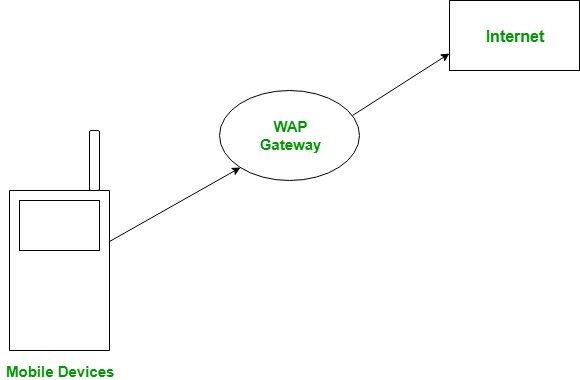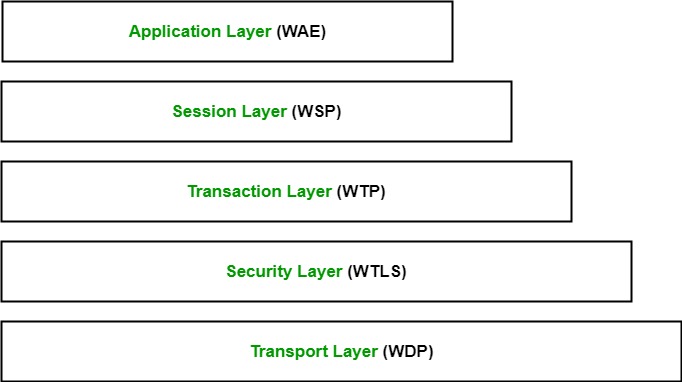Wireless Application Protocol
Last Updated :
28 Aug, 2023
The Wireless Application Protocol (WAP) is a set of communication protocols and an application programming model based on the World Wide Web (WWW). Its hierarchical structure is quite similar to the TCP/IP protocol stack design.
What is Wireless Application Protocol (WAP)?
WAP stands for Wireless Application Protocol. It is a protocol designed for micro-browsers and it enables access to the internet in mobile devices. It uses the markup language WML (Wireless Markup Language and not HTML), WML is defined as an XML 1.0 application. It enables the creation of web applications for mobile devices. In 1998,
WAP Forum was founded by Ericson, Motorola, Nokia and Unwired Planet whose aim was to standardize the various wireless technologies via protocols. WAP protocol resulted from the joint efforts of the various members of WAP Forum. In 2002, WAP forum was merged with various other forums in the industry resulting in the formation of
Open Mobile Alliance (OMA)

WAP Model
The user opens the mini-browser in a mobile device. He selects a website that he wants to view. The mobile device sends the URL encoded request via network to a WAP gateway using WAP protocol.

The WAP gateway translates this WAP request into a conventional HTTP URL request and sends it over the internet. The request reaches to a specified web server and it processes the request just as it would have processed any other request and sends the response back to the mobile device through WAP gateway in WML file which can be seen in the micro-browser.
WAP Protocol stack

- Application Layer: This layer contains the Wireless Application Environment (WAE). It contains mobile device specifications and content development programming languages like WML.
- Session Layer: This layer contains Wireless Session Protocol (WSP). It provides fast connection suspension and reconnection.
- Transaction Layer: This layer contains Wireless Transaction Protocol (WTP). It runs on top of UDP (User Datagram Protocol) and is a part of TCP/IP and offers transaction support.
- Security Layer: This layer contains Wireless Transport Layer Security (WTLS). It offers data integrity, privacy and authentication.
- Transport Layer: This layer contains Wireless Datagram Protocol. It presents consistent data format to higher layers of WAP protocol stack.
Why Use WAP?
The following advantages for wireless network operators, content producers, and end users were put out by WAP when it was first introduced in 1999:
Operators of wireless networks and mobile phones: WAP was created with the intention of enhancing already-existing wireless data services, such as voicemail, and facilitating the creation of new mobile applications. Without making any further infrastructure adjustments or phone modifications, these applications might be created.
Content Provider: For third-party application developers, WAP opened up a market for extra applications and mobile phone features. It was suggested that developers use the WML programming language to write applications for mobile devices.
End users: Access to online services like banking, entertainment, messaging, and other information on mobile devices should be simple and safe for users of mobile phones. WAP could also permit access.
Advantages of Wireless Application Protocol
The benefits of Wireless Application Protocol, or WAP, are listed below:
- WAP is a rapidly evolving technology.
- Wireless Application Protocol is an open source that is totally free of cost.
- WAP can be used over multiple platforms.
- Neither it nor network standards are affected.
- Higher controlling possibilities are offered.
- It follows a model that is similar to the Internet.
- You can send and receive real-time data with WAP.
- WAP is supported by the majority of current mobile phones and devices.
Disadvantages of Wireless Application Protocol
The following is a list of various Wireless Application Protocol, or WAP, drawbacks:
- WAP connection speed is slow and number of connections are less.
- At some places it is very difficult to access the Internet, and also at some places it is totally impossible.
- Less secure.
- WAP provides a small User interface (UI).
Wireless Application Protocol – FAQs
1. Why do we need WAP?
Internet access was only accessible from your computer until the release of the first WAP devices. With WAP, you may now use your mobile phone to use the Internet to interact with other people. large global communication and data sharing are therefore expanded.
2. What is a Micro WAP Browser?
There is a WAP browser available as well, just like your personal internet browser. Micro WAP Browser is the name of the browser used to access websites using a WAP device. What makes it unique is that it uses less hardware, memory, and CPU resources and presents the data in WML, a constrained mark-up language.
3. What is WAP 2.0?
WAP 2.0, which was introduced in 2002, is only a combination of end-to-end HTTP and XHTML. The gateway and custom protocol suite that were used to communicate with have been removed.
Like Article
Suggest improvement
Share your thoughts in the comments
Please Login to comment...